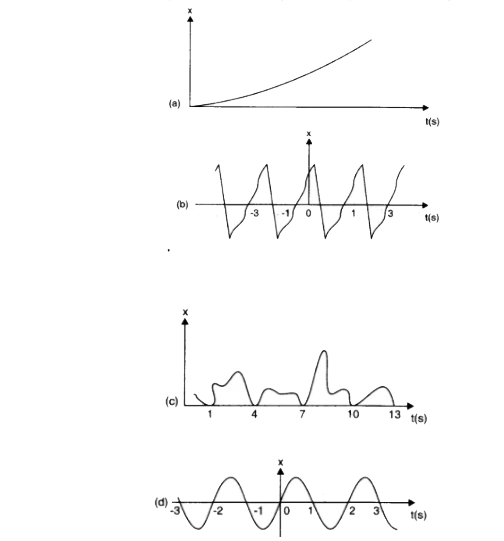What is periodic motion ?
The correct Answer is:A motion which repeats itself over and over again after a regular interval of time is called a periodic motion.
Step-by-Step Solution:
1. Definition of Periodic Motion:
- Periodic motion is defined as a type of motion that repeats itself after a fixed interval of time.
2. Time Period:
- The fixed interval of time after which the motion repeats is known as the time period. It is a crucial aspect of periodic motion.
3. Examples of Periodic Motion:
- To illustrate periodic motion, consider a daily routine. For instance, if you leave your home for work at a specific time every morning and return home at a specific time in the evening, this routine exemplifies periodic motion. The time taken for each complete cycle (from home to office and back) represents the time period of this motion.
4. Characteristics of Periodic Motion:
- In periodic motion, the object returns to its initial position after each time period, and the motion can be uniform or non-uniform.
5. Conclusion:
- Therefore, periodic motion is characterized by its repetitive nature and the consistent time interval (time period) between each repetition.
- Periodic motion is defined as a type of motion that repeats itself after a fixed interval of time.
- The fixed interval of time after which the motion repeats is known as the time period. It is a crucial aspect of periodic motion.
- To illustrate periodic motion, consider a daily routine. For instance, if you leave your home for work at a specific time every morning and return home at a specific time in the evening, this routine exemplifies periodic motion. The time taken for each complete cycle (from home to office and back) represents the time period of this motion.
- In periodic motion, the object returns to its initial position after each time period, and the motion can be uniform or non-uniform.
- Therefore, periodic motion is characterized by its repetitive nature and the consistent time interval (time period) between each repetition.
Topper's Solved these Questions
- SIMPLE HARMONIC MOTION BOOK - RESONANCE ENGLISHCHAPTER - SIMPLE HARMONIC MOTION EXERCISE - Exercise- 1, PART - I
25 Videos
- SIMPLE HARMONIC MOTION BOOK - RESONANCE ENGLISHCHAPTER - SIMPLE HARMONIC MOTION EXERCISE - Exercise- 1, PART - II
36 Videos
- SIMPLE HARMONIC MOTION BOOK - RESONANCE ENGLISHCHAPTER - SIMPLE HARMONIC MOTION EXERCISE - Solved Miscellaneous Problems
9 Videos
- SEMICONDUCTORSBOOK - RESONANCE ENGLISHCHAPTER - SEMICONDUCTORSEXERCISE - Exercise 3
88 Videos
- TEST PAPERSBOOK - RESONANCE ENGLISHCHAPTER - TEST PAPERSEXERCISE - PHYSICS
784 Videos
Similar Questions
Categorise the following function of time eω2t as
(a) S.H.M.
(b) Periodic but not S.H.M. Also , give period if it is periodic motion.
Hint : Doest it repeat itself ?
View SolutionFig. 14.23 depicts four x-t plots for linear motion of a particle. Which of the plots represent periodic motion? What is the period of motion (in case of periodic motion) ?

View Solution
Knowledge Check
Which one of the following is not a periodic motion?
ARotation of the earth about its axis.BA freely suspended bar magnet displaced from its N-S direction and released.CMotion of hands of a clock.DAn arrow released from a bow.Assertion: A combination of two simple harmonic motions with a arbitrary amplitudes and phases is not necessarily periodic.
Reason: A periodic motion can always be expressed as a sum of infinite number of harmonic motions with appropriate amplitudes.AIf both assertion and reson are true and reason is the correct explanation of assertionBIf both assertion and reason are true but reason is not the correct explanation of assertion.CIf assertion is true but reason is false.DIf both assertion and reason are false.
What is periodic abstinence?
View SolutionExplain periodic motion and oscillatory motion with illustrations.
View SolutionAssertion : All oscillatory motions are necessarily periodic motion but all periodic motion are not oscillatory.
Reason : Simple pendulum is an example of oscillatory motion.
View SolutionStatement-1 : SHM is not a periodic motion.
Statement-2 : Periodic motion does not repeat its position after certain interval of time.
View SolutionWhich of the following functions of time represented (a) periodic and (b) non-periodic motion ? Given the period for each case of periodic motion (ω is any positive constant(i)sinωt−cosωt(ii)log(2ω)
View SolutionThe left block in figure moves at a speed v towards the right block placed in equilibrium. All collisions to take place are elastic and the surfaces are frictionless. Show that motion of the two blocks are periodic. Find the time period of these periodic motions. Neglect the widths of the blocks.

View Solution
